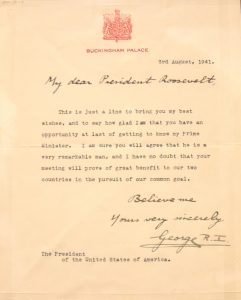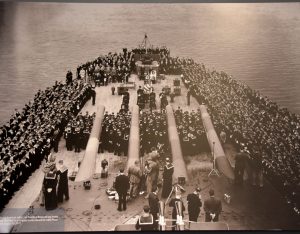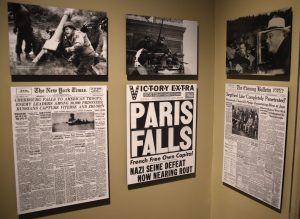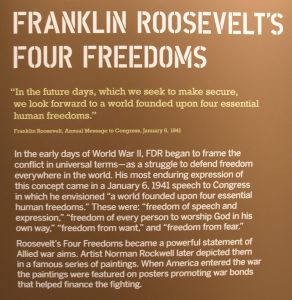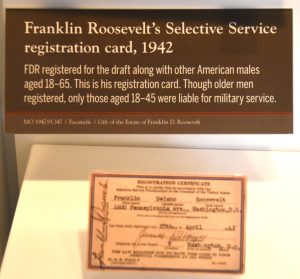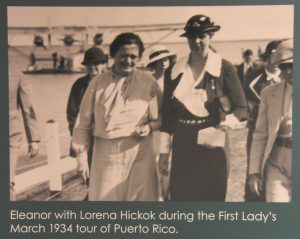We returned to the Franklin Delano Roosevelt Library/Springwood complex in Hyde Park  this morning to visit FDR's presidential musuem … our last of the National Park Services' 13 such presidential libaraies/musuems.
this morning to visit FDR's presidential musuem … our last of the National Park Services' 13 such presidential libaraies/musuems.
Leaving the Visitor's Center we passed Franklin and Eleanor
 before arriving at the musuem … which opened on June 30, 1941, the only such museum to open during a president's term in office.
before arriving at the musuem … which opened on June 30, 1941, the only such museum to open during a president's term in office.
 Designed by Roosevelt, it was in the Dutch colonial style. The library holds more than 17 million pages of documents.
Designed by Roosevelt, it was in the Dutch colonial style. The library holds more than 17 million pages of documents.
After entering the foyer
 we were advised the D-Day exhibit
we were advised the D-Day exhibit
 which we toured before entering the main museum. The main focus appeared to events leading up to D-Day and around the growing friendship which developed between Roosevelt and Winston Churchill … and the rift between Roosevelt and Stalin, who had pushed for the Allies to open a second front in 1942, rather than liberaating North Africa and then the "Soft Underbelly" of Italy before invating "Fortress Europe" through France.
which we toured before entering the main museum. The main focus appeared to events leading up to D-Day and around the growing friendship which developed between Roosevelt and Winston Churchill … and the rift between Roosevelt and Stalin, who had pushed for the Allies to open a second front in 1942, rather than liberaating North Africa and then the "Soft Underbelly" of Italy before invating "Fortress Europe" through France.
Notice Roosevelt's right foot
Encryption devise used by Roosevelt and Churchill to communicate directly with each other
Other than some newsreel videos and some very large maps of the Normandy coast depicting the routes taken by the invastion forces, there was not a great deal actual the D-Day invasion.
Entering the museum, we were taken on a tour of his and Elanor's lives form their youth
As was the case with Hoover, Truman and Eisenhower presidential msueums, many of the exhibits were stored in plastic or glass cases, often illuminated with multiple harsh spot lights, making them difficult to photograph, and details about their Administrations presented through "signs" or blown-up newspaper reprints.
From his earliest forays into politics, FDR was a rising star and seemed an unstoppable political force.
Along the way constantly trying to model his political career around the successss of his Uncle Teddy Roosevelt.
Then …
For the next seven years, while he became mostly invisible from the political scene, Eleanor and his closest political advisor worked tirelessly to keep him in the public political discourse and spotlight.
In 1928 FDR began to reenter the political landscape when he ran for and was elected as New York's 44th governor. A year later, the Great Depression.
FDR then sought and won the 1932 Democratic nomination for president on the 4th ballot after cutting a deal with his then rival and Speaker of the House, John Nance Garner.
FDR's campaign hat
Roosevelt won a landslide vistory with 472 electoral ballots to just 59 for the incombent, Herbert Hoover. As this was several years before the adoption of the Twentieth Amedment which set the terms of "the President and Vice President shall end at noon on the 20th day of January", his inauguration was not scheduled until March 1933.
Roosevelt riding during a post-election rally … then moments later …
Hoover and Roosevelt riding to the inauguration
 A copy of his Inauguration speech is available to read on the above podium
A copy of his Inauguration speech is available to read on the above podium
 Franklin Delano Roosevelt took his oath of office on the Roosevelt family Dutch Bible, opened to a verse in St. Paul's Epsitle to the Cornithians; "And now abideth faith, hope and charity, these three; but the greatest of these is charity."
Franklin Delano Roosevelt took his oath of office on the Roosevelt family Dutch Bible, opened to a verse in St. Paul's Epsitle to the Cornithians; "And now abideth faith, hope and charity, these three; but the greatest of these is charity."
FDR used this RCA Model 4-A-1 carboncondernser microphone to deliever some of his Fireside Chats from the White House during the 1930s
Typical 1930s family kitchen where millions of Americans listened to Roosevelt's Fireside Chats
Many exhibit stands, plaques, posters and photos covered the varied accomplishments of Roosevelts first and second terms in office.
The museum also covered both his
A second term
Among Roosevelt's second term setbacks was his ill-advised plan to "pack" the Supreme Court. 
Below is the actual office in the mueeum which was used by President Roosevelt while in office. He used it as a place to conduct government business, receive vistiors and work on his books and papers during his many visits to Hyde Park (totaling over 250 days) during World War II. He also made several of his Fireside Chats and famous speeches from this room. It finally opened to the public in June 1941, shortly after the beginning of his third term.
While still mired in his recovery efforts from the Depression, ominous clouds were descening across both Europe and the western Pacific regions. 
Then, at 2:50 Am on September 2nd, 1939, the president was awakened with the news that Germany had invaded Poland.
While he was keenly aware that this would bring England and France into war with Hitler, he was stimied in his instincts to provide assistance from an overwhelming desire to remain neutral by both Congress and the nation. In the days before he was able to convince Congress of his sccessful "Lend Lease" program, he tacitly encouraged Americans, "This nation will remain a neutral nation, but I cannot ask that every Americcan remain neutral in thought as well. Even a neutral cannot be asked to close his mind or his conscience."
The 1940 election was the most challenging and divisive of FDR’s political career. His decision to seek an unprecedented third term inflamed his opponents and even some of his supporters, suggesting he wanted to become a dictator. Further, his ceaseless efforts to provide military and other aid to countries fighting the Axis Powers in the face of a nation wanting to remain neutral exacerbated the cries to denounce his decsion to run.
While there was no constitutional barrier to a third term in 1940, no president had ever exceeded the two-term precedent established by George Washington. Ultimately, his second and third terms lead to a Constitutional Amendment limiting a president to two terms. 
It wasn't until December 8th, the day after the Japanese attack on Pearl Harbor, that Roosevelt gave his Day of Infamy speach before Congress and asked them for a Declaration of War against Japan. Interestingly, The last time Congress passed joint resolutions saying that a "state of war" existed … the only way under the Constitution for American to declare war … was on June 5, 1942, when the U.S. declared war on Bulgaria, Hungary, and Romania. Since then, the US has used the term "authorization to use military force", for which there is no Constitutional provision.
It was during World War II that two decisions Roosevelt made perhaps most tarnished he image and legacy. The first was his Executive Order for the internment of Japanese-Americans.
The second was his defacto agreement to not take aggressive actions to bomb the rail lines leading to the Auschwitz, Belzec, Chelmno, Dachau, Majdanek, Sobibor, Treblinka and other concentration camps, thereby eliminating the NAZIs of a means to transport Jews and other undesirables to their deaths.
Of course there were other critics of Roosevelt's New Deal, World War II and other initiatives … and the Museum displays dozens of these critiques.
However, Roosevelt could not be critized for keeping his sons out of harm's way, as all of them served.
FDR also registered for the draft, albeit there was no chance of him being called up.
Using a technique he honed during the depression, FDR continued to have a conversation with the americans throughout the war
 and Americans tuned in their radios by the millions.
and Americans tuned in their radios by the millions.
In the years since Roosevelts presidency, the government has tried to have an ecomnomy providing both "guns and butter". However, during World War II, Americans had to pull in their belts and use Ration Books to obtain even some of life's basic necessities.
In 1944, Roosevelt, the only president many Americans ever knew ran for an unprecedented fourth term, this time choosing a relatively unknown Senator from Missouri as his running mate.
And he won 36 states and defeated Thomas Dewey by a margin of 432 to 99 votes in the electorial college. Less than three months later he passed away … just two weeks before Germany's surrender … while relaxing in Warm Springs, GA (where we've also visited) …
Winston Chruchill with Eleanor payig his respects to his friend, Franklin
Before and during his years as president, personal scandals swirllled around Franklin and, to a lesser extent, Eleanor.
Yet, for all of his weaknesses and missteps, FDR is remembered for both leading the free world to victory in World War II and in changing governments role in providing for the American people.
Toward the end of the exhibit halls, there was a section dedicated to the amazing life of Eleanor Roosevelt.
In the years after FDR's death, Eleanor continued her work as a prolific writer. She used this 1939 L.C. Smith typewriter when working on books, articles and more than 7,000 "My Day" newspaper columns.
Eleanor, took this suitcase along on her many worldwide travels throughout the 1950s and 1960s.
While her lifetime of activism brought Elanor Roosevelt the gratitude and devotion of millions of people … J. Edgar Hoover, who led the FBI from 1924 until 1972,was deeply suspicious of her political activities and associates, especially when it came to civil rights and civil liberties. Hoover falsely believed she was a communist or a communist pawn. The FBI gathered an enormous file on her, one of the largest the agency everr compiled on an individual. The file began in 1924 and contiued to her death in 1962. Many of her critics volunteered informaiton to the FBI, and thus, the file is full of unsubstantiated gossip. Almost 90% of the file concerns her civil rights work. The above file draw contains cpies of the publicly-released file on Eleanor.
In the basement were many items including, among other memorabilia his personal limo,
An inmate at Sing SI\ing State Prison in Ossning, NY built the above model and sent it to then Governonr Franklin Roosevelt in 1930 as a gift. The ship's name, "Pardon Me", reflected the prisoner's hope for a reprieve from the Governor. However, Presidential Library records do not indicate the name of the prisoner nor his fate.
and furniture made a Eleanor's Val-Kill Industries factory.
Behind the museum we discovered "Freedom Court", an interesting two-part … Shared Values and Breaking Free … exhibit.
It commemorates the shared vision of two great warriors of freedom, Franklin Delano Roosevelt and Winston Spence Churchill. During the darkest days of World War II, the envisioned a future where democracy and freedom would flourish. These goals were enshrined in FDR’s “Four Freedoms”.
Yet soon after the allied victory in 1945, their vision was overshadowed. In Churchill’s words during a speech in Iowa that “an Iron Curtain had descended across Europe”. It separated the free world from communism, thus beginning the “Cold War”.
In 1961, the Berlin Wall became the phyysical embodiment of the Iron Curtain. It’s fall in 1989 marked the end of the Cold War.
The sculpture at the rear of Freedom Court, “Break Free” was created from sections of the Berlin Wall by artist Edwina Sandys, grandaughter of Winston Churchill. Human figures are show breaking free of the symbolic barbed wire … expressing freedom’s triumph over totalitarianism.
Break Free embodies the noble principals championed by Franklin Roosevelt and Winston Churchill.
Before leaving, I got a chance to finally chat with some new found friends.





